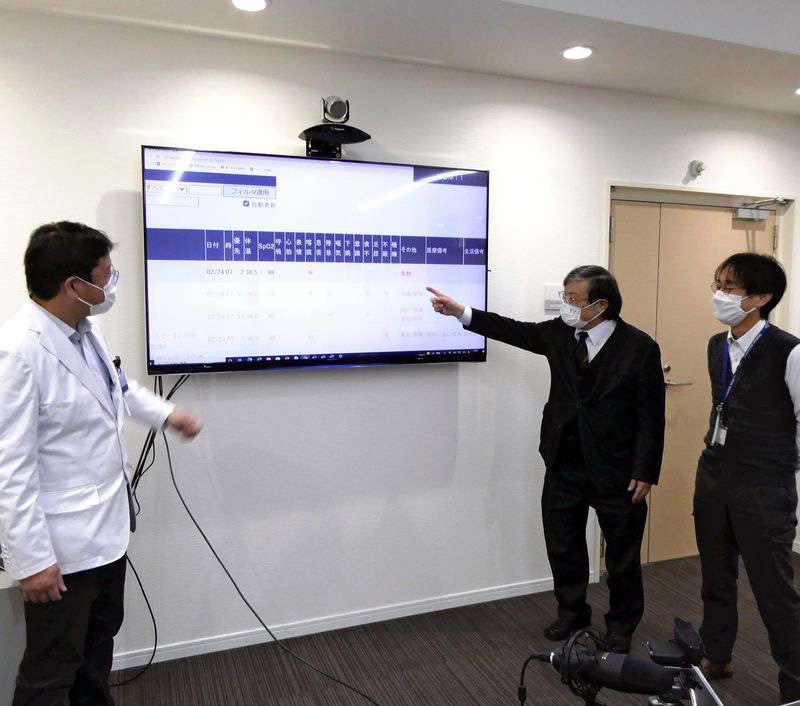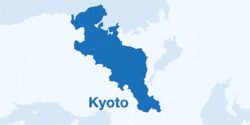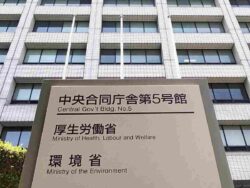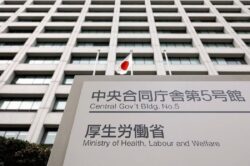
University of Yamanashi President Shinji Shimada, center, speaks about the Shingen patient management system at the university’s Faculty of Medicine in Chuo, Yamanashi Prefecture.
16:46 JST, March 5, 2022
KOFU — With omicron coronavirus cases still rampant in some areas of Japan, Yamanashi Prefecture has managed to avoid quasi-emergency restrictions during the sixth wave of infections.
A patient management system developed by the University of Yamanashi called Shingen has been a major factor in the prefecture’s pandemic response, of which a distinctive feature is that all coronavirus patients are under the supervision of doctors and other medical personnel, in principle.
The prefecture’s coordination team groups patients into three categories: people who need to be hospitalized, those assigned to accommodation facilities and those who can recuperate at home.
Some of the prefecture’s accommodation facilities have enhanced medical care functions where at least one doctor is stationed full time. People who need care after being discharged from hospitals or accommodation facilities are also provided with the required support.
As the number of patients increases, it takes more time to categorize patients. The prefecture launched a system dubbed “first care” to connect patients to doctors during busy periods.
The Shingen system is mainly used for the first-care, home-care and post-discharge programs, as well as at accommodation facilities with enhanced medical functions.
Patients register their details on the Shingen system via smartphones and other devices, and enter such information as body temperature, blood oxygen levels and symptoms twice a day.
Shingen stands for Smart Health Information Gathering and Evaluation Network. One of the advantages of the system is that it is easy for doctors to check and share patient information. Patients are given scores based on the information they have inputted.
The higher the score the higher the risk, with the highest risk patients indicated in red at the top of patient lists, making it easier for medical personnel to grasp the status of situations.
Osamu Inoue, deputy director of the infection control department at the University of Yamanashi Hospital, said, “The system was essential also for doctors from the Yamanashi Medical Association who’ve been working with us.”
All information on the system can be shared among general practitioners and doctors at the university hospital.
The university tried to reflect the opinions of medical professionals to make the system user-friendly.
During the fifth wave of infections last summer, the university hospital was responsible for providing care at accommodation facilities with enhanced medical functions.
Medical personnel had been using paper documents and whiteboards to manage patient information, but as the number of patients surged, managing the information took up a lot of the team’s time.
On-site doctors created a simple system to efficiently manage patient information that was used as the basis for the current system, which was further developed by adding more patient information and linking it with a system through which patients recuperating at home can request supplies of daily necessities.
Medical personnel can now check information about patients, the status of accommodation facilities and daily supply requests at a glance, on large displays that have been installed at accommodation facilities with enhanced medical functions.
Up to about 600 rooms in three locations are handled by six doctors and six nurses, according to the university.
As a national university, Yamanashi was among the first institutions in Japan to implement pandemic measures, which led to the development of the Shingen system.
Shinji Shimada, the president of the university, said, “We’ve always had a sense of urgency in dealing with the pandemic. We’d like to continue providing medical care for residents in the prefecture, including the operation of the system.”
"Society" POPULAR ARTICLE
-

M4.9 Earthquake Hits Tokyo, Neighboring Prefectures
-

Israeli Tourists Refused Accommodation at Hotel in Japan’s Nagano Pref., Prompting Protest by Israeli Embassy and Probe by Prefecture
-

M7.5 Earthquake Hits Northern Japan; Tsunami Waves Observed in Hokkaido, Aomori and Iwate Prefectures
-

Tsukiji Market Urges Tourists to Avoid Visiting in Year-End
-

High School in Kyoto Says Students Shoplifted during Recent School Trip to Bali, Indonesia
JN ACCESS RANKING
-

Tokyo Economic Security Forum to Hold Inaugural Meeting Amid Tense Global Environment
-

Keidanren Chairman Yoshinobu Tsutsui Visits Kashiwazaki-Kariwa Nuclear Power Plant; Inspects New Emergency Safety System
-

Imports of Rare Earths from China Facing Delays, May Be Caused by Deterioration of Japan-China Relations
-

University of Tokyo Professor Discusses Japanese Economic Security in Interview Ahead of Forum
-

Japan Pulls out of Vietnam Nuclear Project, Complicating Hanoi’s Power Plans

























